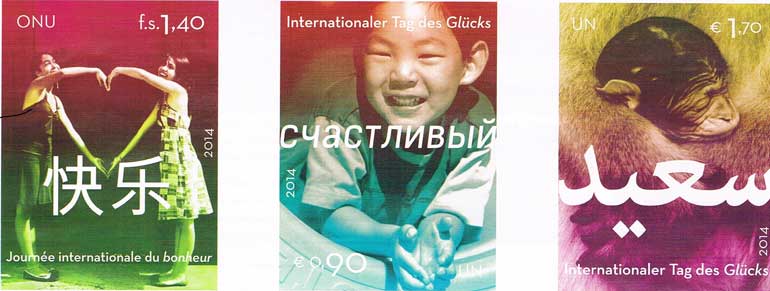Wednesday Feb 12, 2025
Wednesday Feb 12, 2025
Saturday, 4 July 2015 01:22 - - {{hitsCtrl.values.hits}}
Not many of us had heard about the UN International Day of Happiness. I didn’t know about it till I came across a copy of ‘Fascination’, UN philatelic bulletin. 20 March is the day.
It was three years ago that the UN General Assembly adopted the Resolution declaring 20 March the International Day of Happiness. It recognised happiness as a “fundamental human goal” and called for “a more inclusive, equitable and balanced approach to economic growth that promotes the happiness and well-being of all peoples”.
The bulletin features six stamps on the theme ‘Happiness’ issued to mark Happiness Day last year. The designs used are images of happiness. The word ‘happy’ has been used in the six official languages of the United Nations – Arabic, Chinese, English, French, Russian and Spanish.

The designs depict ‘A woman smiling’ (English), ‘Business people kissing on the beach’ (Spanish), ‘A sweet dog’s muzzle’ (French), ‘Side profile of two young women’ (Chinese), ‘Happy Asian boy at the park’ (Russian) and ‘Barbary macaque – a monkey species – with baby’ (Arabic).
In a short message, UN Secretary-General Ban Ki-moon states: “The pursuit of happiness lies at the core of human endeavours. People around the world aspire to lead happy and fulfilling lives free from fear and want, and in harmony with nature. Let us reinforce our commitment to inclusive and sustainable human development and renew our pledge to help others. When we contribute to the common good, we ourselves are enriched. Compassion promotes happiness and helps build the future we want.”
The UN Resolution reads: Conscious that the pursuit of happiness is a fundamental human goal; recognising also the need for a more inclusive, equitable and balanced approach to economic growth that promotes sustainable development, poverty eradication, happiness and the well-being of all peoples, decides to proclaim 20 March the International Day of Happiness, invites all Member States, organisations of the United Nations system and other international and regional organisations, as well as civil society, including non-governmental organisations and individuals, to observe the International Day of Happiness in an appropriate manner, including through education and public awareness-raising activities.

The Resolution was the result of the initiative taken by the Kingdom of Bhutan and it marked the historical milestone of globalising the Happiness Development Movement that started in 1972. That year the King of Bhutan introduced the Gross National Happiness (GNH) philosophy and its four development pillars at an international conference.
Since the inception of Happiness Day, each year the charity ’Action for Happiness‘ coordinates an international campaign to coincide with the day, bringing together a coalition of over 60 organisations to promote positive social action to help create a happier and more caring world.
Action for Happiness helps people take practical action to improve mental wellbeing. The Dalai Lama is the patron of the charity and tens of thousands of members are taking action to increase wellbeing in their homes, workplaces, schools and local communities. Their vision is a happier and less self-centred world, with far fewer people suffering with mental health problems and far more people feeling good, functioning well and helping others.
The 2014 Day of Happiness campaign asked people to share authentic images of what makes them happy to ‘Reclaim Happiness’ from the fake commercial images of happiness that people are so often bombarded with. Thousands of people shared images and the social reach was estimated to be over 13 million people globally.
In 2015 the campaign, titled ‘Your happiness is part of something bigger,’ focused on the importance of human connection in the context of the epidemic of loneliness and isolation in modern societies. They organised happiness flash-mobs in 12 cities across the world to promote the sharing of positive messages on social media.
Discover Kapruka, the leading online shopping platform in Sri Lanka, where you can conveniently send Gifts and Flowers to your loved ones for any event including Valentine ’s Day. Explore a wide range of popular Shopping Categories on Kapruka, including Toys, Groceries, Electronics, Birthday Cakes, Fruits, Chocolates, Flower Bouquets, Clothing, Watches, Lingerie, Gift Sets and Jewellery. Also if you’re interested in selling with Kapruka, Partner Central by Kapruka is the best solution to start with. Moreover, through Kapruka Global Shop, you can also enjoy the convenience of purchasing products from renowned platforms like Amazon and eBay and have them delivered to Sri Lanka.
Discover Kapruka, the leading online shopping platform in Sri Lanka, where you can conveniently send Gifts and Flowers to your loved ones for any event including Valentine ’s Day. Explore a wide range of popular Shopping Categories on Kapruka, including Toys, Groceries, Electronics, Birthday Cakes, Fruits, Chocolates, Flower Bouquets, Clothing, Watches, Lingerie, Gift Sets and Jewellery. Also if you’re interested in selling with Kapruka, Partner Central by Kapruka is the best solution to start with. Moreover, through Kapruka Global Shop, you can also enjoy the convenience of purchasing products from renowned platforms like Amazon and eBay and have them delivered to Sri Lanka.